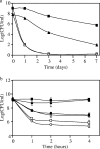Distribution of cepacian biosynthesis genes among environmental and clinical Burkholderia strains and role of cepacian exopolysaccharide in resistance to stress conditions
- PMID: 19948863
- PMCID: PMC2805225
- DOI: 10.1128/AEM.01828-09
Distribution of cepacian biosynthesis genes among environmental and clinical Burkholderia strains and role of cepacian exopolysaccharide in resistance to stress conditions
Abstract
The genus Burkholderia includes strains pathogenic to animals and plants, bioremediators, or plant growth promoters. Genome sequence analyses of representative Burkholderia cepacia complex (Bcc) and non-Bcc strains for the presence of the bce-I gene cluster, directing the biosynthesis of the exopolysaccharide (EPS) cepacian, further extended this previously described cluster by another 9 genes. The genes in the bce-II cluster were named bceM to bceU and encode products putatively involved in nucleotide sugar precursor biosynthesis and repeat unit assembly, modification, and translocation across the cytoplasmic membrane. Disruption of the B. cepacia IST408 bceQ and bceR genes, encoding a putative repeat unit flippase and a glycosyltransferase, respectively, resulted in the abolishment of cepacian biosynthesis. A mutation in the bceS gene, encoding a putative acyltransferase, did not affect EPS production yield significantly but decreased its acetylation content by approximately 20%. Quantitative real-time reverse transcription-PCR experiments confirmed the induction of genes in the bce-I and bce-II clusters in a Burkholderia multivorans EPS producer clinical isolate in comparison to the level for its isogenic EPS-defective strain. Fourier Transform infrared spectroscopy analysis confirmed that the exopolysaccharide produced by 10 Burkholderia isolates tested was cepacian. The ability of Burkholderia strains to withstand desiccation and metal ion stress was higher when bacteria were incubated in the presence of 2.5 g/liter of cepacian, suggesting that this EPS plays a role in the survival of these bacteria by contributing to their ability to thrive in different environments.
Figures






Similar articles
-
Plant host and sugar alcohol induced exopolysaccharide biosynthesis in the Burkholderia cepacia complex.Microbiology (Reading). 2008 Aug;154(Pt 8):2513-2521. doi: 10.1099/mic.0.2008/019216-0. Microbiology (Reading). 2008. PMID: 18667584
-
Insights into the role of extracellular polysaccharides in Burkholderia adaptation to different environments.Front Cell Infect Microbiol. 2011 Dec 15;1:16. doi: 10.3389/fcimb.2011.00016. eCollection 2011. Front Cell Infect Microbiol. 2011. PMID: 22919582 Free PMC article. Review.
-
Growth on mannitol-rich media elicits a genome-wide transcriptional response in Burkholderia multivorans that impacts on multiple virulence traits in an exopolysaccharide-independent manner.Microbiology (Reading). 2014 Jan;160(Pt 1):187-197. doi: 10.1099/mic.0.072975-0. Epub 2013 Nov 6. Microbiology (Reading). 2014. PMID: 24196427
-
Exopolysaccharides produced by clinical strains belonging to the Burkholderia cepacia complex.J Cyst Fibros. 2007 Apr;6(2):145-52. doi: 10.1016/j.jcf.2006.06.004. Epub 2006 Jul 21. J Cyst Fibros. 2007. PMID: 16860003
-
Burkholderia cenocepacia in cystic fibrosis: epidemiology and molecular mechanisms of virulence.Clin Microbiol Infect. 2010 Jul;16(7):821-30. doi: 10.1111/j.1469-0691.2010.03237.x. Clin Microbiol Infect. 2010. PMID: 20880411 Review.
Cited by
-
Structure of Burkholderia cepacia UDP-glucose dehydrogenase (UGD) BceC and role of Tyr10 in final hydrolysis of UGD thioester intermediate.J Bacteriol. 2011 Aug;193(15):3978-87. doi: 10.1128/JB.01076-10. Epub 2011 May 20. J Bacteriol. 2011. PMID: 21602353 Free PMC article.
-
The complete genome of Burkholderia phenoliruptrix strain BR3459a, a symbiont of Mimosa flocculosa: highlighting the coexistence of symbiotic and pathogenic genes.BMC Genomics. 2014 Jun 28;15(1):535. doi: 10.1186/1471-2164-15-535. BMC Genomics. 2014. PMID: 24972629 Free PMC article.
-
The Exopolysaccharide Cepacian Plays a Role in the Establishment of the Paraburkholderia phymatum - Phaseolus vulgaris Symbiosis.Front Microbiol. 2020 Jul 16;11:1600. doi: 10.3389/fmicb.2020.01600. eCollection 2020. Front Microbiol. 2020. PMID: 32765457 Free PMC article.
-
Commonalities and differences in regulation of N-acyl homoserine lactone quorum sensing in the beneficial plant-associated burkholderia species cluster.Appl Environ Microbiol. 2010 Jul;76(13):4302-17. doi: 10.1128/AEM.03086-09. Epub 2010 Apr 30. Appl Environ Microbiol. 2010. PMID: 20435760 Free PMC article.
-
Characterization of the Thermostable Biosurfactant Produced by Burkholderia thailandensis DSM 13276.Polymers (Basel). 2022 May 20;14(10):2088. doi: 10.3390/polym14102088. Polymers (Basel). 2022. PMID: 35631971 Free PMC article.
References
-
- Bartholdson, S. J., A. R. Brown, B. R. Mewburn, D. J. Clarke, S. C. Fry, D. J. Campopiano, and J. R. Govan. 2008. Plant host and sugar alcohol induced exopolysaccharide biosynthesis in the Burkholderia cepacia complex. Microbiology 154:2513-2521. - PubMed
-
- Buendia, A. M., B. Enenkel, R. Koplin, K. Niehaus, W. Arnold, and A. Puhler. 1991. The Rhizobium meliloti exoZl exoB fragment of megaplasmid 2: ExoB functions as a UDP-glucose 4-epimerase and ExoZ shows homology to NodX of Rhizobium leguminosarum biovar viciae strain TOM. Mol. Microbiol. 5:1519-1530. - PubMed
-
- Bullock, W. C., J. M. Fernandz, and J. M. Short. 1987. XL1-Blue: a high efficiency plasmid transforming recA Escherichia coli strain with beta-galactosidase selection. Biotechniques 5:376-379.
-
- Bylund, J., L. A. Burgess, P. Cescutti, R. K. Ernst, and D. P. Speert. 2006. Exopolysaccharides from Burkholderia cenocepacia inhibit neutrophil chemotaxis and scavenge reactive oxygen species. J. Biol. Chem. 281:2526-2532. - PubMed
Publication types
MeSH terms
Substances
LinkOut - more resources
Full Text Sources
Molecular Biology Databases

